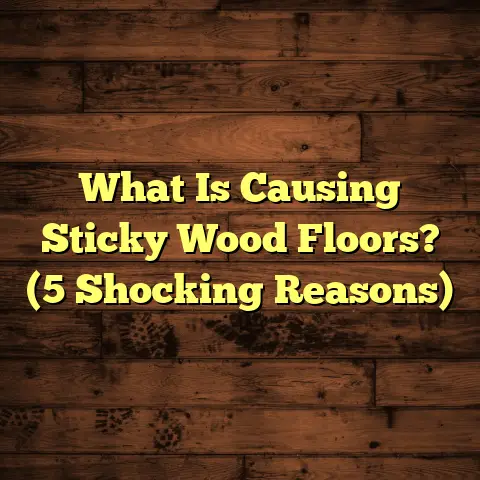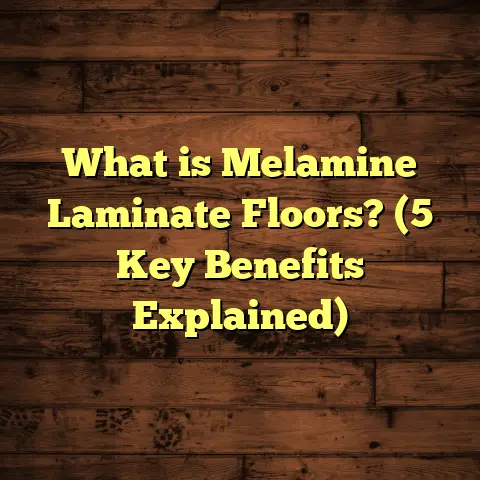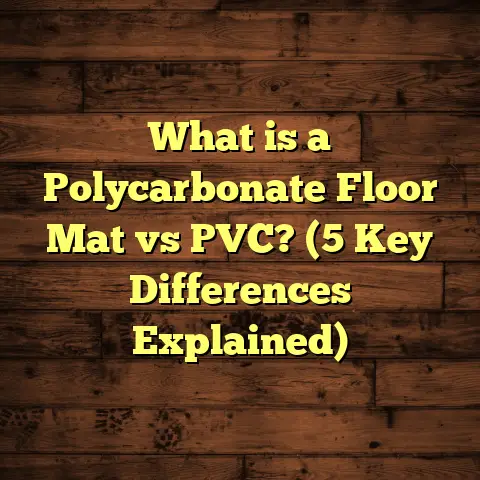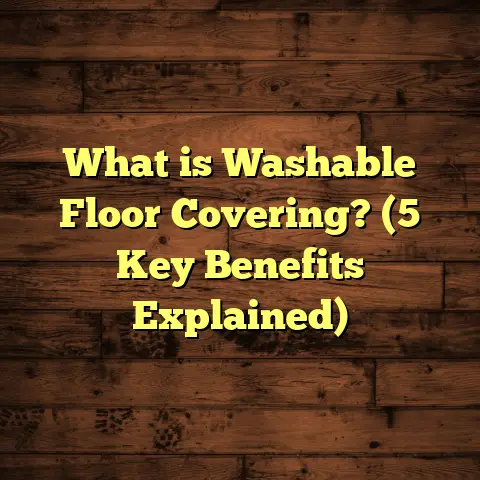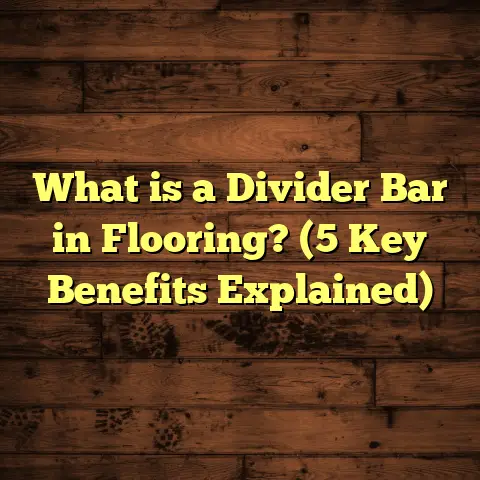What is Quarter Round Made Of? (5 Key Materials Explained)
Introduction: Why Quarter Round Is Trending in Flooring Projects
Have you noticed how more and more homes these days have this neat little trim at the bottom of the walls, right where the floor meets the baseboard? That’s quarter round molding, and it’s quietly become one of those overlooked but essential pieces in home design. When I first started in flooring about 15 years ago, most people didn’t pay much attention to this small detail. But recently, quarter round has gained a lot of traction as homeowners realize how much it can enhance a room’s finished look.
I remember a project from late 2022 in Portland, Oregon. The client was doing a full remodel and wanted every inch of their space to look polished, from the floors to the ceiling. They were debating between different flooring materials and finishes, but what really stuck with me was how much time we spent on picking the right quarter round. They were so particular about the material, color, and profile. It made me think: What exactly is quarter round made of? And why does it matter so much?
If you’re thinking about upgrading your floors or installing new quarter rounds, knowing what materials are out there can save you money, time, and frustration. Over the years, I’ve worked with various types of quarter rounds—wood, MDF, vinyl, rubber, even metal—and each has its own pros and cons depending on your project.
In this article, I’ll walk you through five key materials used for quarter rounds. I’ll share my personal experiences, some numbers on pricing and sizes, and even tips on installation and maintenance. Let’s get into it!
What Is Quarter Round?
Quarter round is a type of molding used primarily as a finishing trim where floors meet walls or baseboards. If you look at its cross-section, it’s basically a quarter of a circle (hence the name). Usually, quarter rounds are about ¾ inch by ¾ inch in thickness and height, though you’ll find slight variations.
Why Use Quarter Round?
You might wonder: if you have baseboards already installed, why add quarter round? Good question! The main functions include:
- Covering gaps: Floating floors like laminate or engineered hardwood need space to expand and contract. Quarter round hides the expansion gap that baseboards can’t cover.
- Aesthetic finishing: It gives a clean, polished edge to floors that otherwise may look unfinished or rough.
- Protection: It protects floor edges from damage caused by foot traffic or cleaning tools.
- Easy replacement: If you damage the quarter round, it’s cheaper and easier to replace than baseboards or flooring.
I’ve found that skipping quarter round often results in a room looking incomplete. It’s like putting on your shoes without socks — functional but not quite finished.
1. Wood Quarter Round
Wood has been the go-to material for quarter round for generations. It’s traditional, versatile, and offers a warm natural look.
Types of Wood Used
Over time, I’ve worked with several species:
- Pine: The most common and affordable option. It’s softwood, so it dents easily but is great for painted trims.
- Oak: A hard hardwood with a prominent grain pattern. Oak is durable and excellent for staining.
- Maple: Harder than oak with a smooth grain; often used for modern aesthetics.
- Poplar: A softer hardwood often chosen because it takes paint well and is budget-friendly.
Sizes
The standard size across most manufacturers is ¾” thickness by ¾” height in lengths of 8 or 12 feet.
Price Points
Here’s what I’ve observed in pricing over recent years (2023-2024):
| Wood Type | Price per Linear Foot (USD) | Average Cost for 100 ft |
|---|---|---|
| Pine | $0.50 – $1.00 | $50 – $100 |
| Oak | $1.50 – $3.00 | $150 – $300 |
| Maple | $2.00 – $3.50 | $200 – $350 |
| Poplar | $1.00 – $1.80 | $100 – $180 |
Prices vary based on local availability and whether the wood is pre-primed or unfinished.
Installation & Finishing
Wood quarter rounds can be painted or stained depending on your room’s design. For example, when I renovated a craftsman-style home in Atlanta last year, we stained oak quarter round to match the hardwood floors perfectly — the color matched almost exactly, making the trim blend seamlessly.
Here are some tips I learned over time:
- Use finishing nails with wood glue for secure attachment.
- Pre-drill holes if working with hard woods to prevent splitting.
- Sand edges lightly before finishing for smoothness.
- Apply two coats of stain or paint for durability.
Maintenance
Wood quarter rounds can dent or scratch but are easy to repair with sanding and refinishing if needed. Keep in mind that if used in damp areas such as bathrooms without sealing, wood can warp or rot over time.
2. MDF (Medium Density Fiberboard) Quarter Round
If you’re looking for a budget-friendly option that still looks good painted white, MDF quarter round is probably on your radar.
What is MDF?
MDF is made by compressing fine wood fibers mixed with resin under heat and pressure. This process creates a dense, smooth material that’s easy to shape and paint.
Why MDF?
MDF comes pre-primed, which saves time on painting prep work. It has no knots or grain patterns, so the surface is uniform — perfect if you want crisp, clean lines.
Cost Breakdown
MDF quarter rounds usually cost around:
- $0.30 to $0.70 per linear foot
For example, I supplied MDF quarter rounds for a 2,000 sq ft townhome project in Dallas last year. We needed about 600 linear feet and paid roughly $350 for all the molding — quite affordable compared to wood.
Installation Notes
- Use finishing nails or brad nails.
- Because MDF is softer than wood, avoid over-driving nails to prevent dents.
- Caulk gaps before painting for a seamless look.
- Avoid moisture exposure as MDF swells when wet.
Limitations
While MDF looks great indoors in dry areas like living rooms or bedrooms, it’s not advisable for bathrooms or basements unless well sealed because it can absorb water and swell.
3. Vinyl Quarter Round
Vinyl quarter round is an excellent option when moisture resistance is a priority.
What Is Vinyl Quarter Round?
Vinyl molding is made from polyvinyl chloride (PVC) or other plastic composites designed to be flexible and water-resistant.
Where It Works Best
I recommend vinyl quarter rounds for bathrooms, laundry rooms, kitchens, basements — any place where wood-based products might degrade quickly due to humidity.
A memorable job was in Seattle in early 2023 where a client had persistent basement moisture problems but wanted an affordable trim option that wouldn’t warp or mold. Vinyl did the trick perfectly.
Pricing
Vinyl costs between:
- $0.50 to $1.20 per linear foot
Vinyl usually comes pre-finished in white or beige but can also be painted with special primers designed for plastic surfaces.
Pros & Cons
Pros:
- Moisture resistant
- Easy to clean
- Flexible — fits uneven surfaces well
- Simple installation with adhesive backing options
Cons:
- Doesn’t have the warmth of wood
- Paint adhesion requires special prep
- Limited colors compared to wood or MDF
Installation Tips
- Clean surface thoroughly before applying adhesive.
- Measure carefully; vinyl can be trimmed with utility knives.
- Use caulking to fill gaps if needed for a better finish.
4. Rubber Quarter Round
Rubber quarter rounds are niche but worth understanding if you want maximum durability in high-impact areas.
What Makes Rubber Unique?
Rubber molding is extremely flexible and resistant to dents, scratches, and moisture. It absorbs impact better than any other material.
I installed rubber quarter round in a commercial gym project in Denver in 2024 where walls faced constant contact from exercise equipment and weights.
Pricing Overview
Rubber molding tends to be pricier:
- Around $1.00 to $2.50 per linear foot depending on thickness and quality.
Where Rubber Fits
Because rubber doesn’t offer much visual appeal for typical home interiors, I mostly recommend it for:
- Commercial spaces
- Garages
- Gyms
- Workshops
It’s tough but not decorative.
Installation Tips
Rubber quarter round can be glued down using strong adhesives designed for vinyl or rubber bonding. Nails aren’t recommended due to flexibility.
5. Metal Quarter Round
Metal is definitely a less common choice but growing in popularity for modern interiors.
What Metals Are Used?
Typically aluminum or stainless steel are the go-to metals for quarter rounds because they resist rust and damage well.
Why Metal?
If your home has an industrial vibe or you want a sleek contemporary look, metal quarter round offers clean lines and durability unmatched by wood or plastic.
During a loft renovation in New York City last summer (2024), I helped install brushed aluminum quarter round around polished concrete floors — it gave a cool contrast that the client loved.
Pricing
Metal quarter rounds cost quite a bit more:
- Between $3 and $7 per linear foot depending on finish (brushed vs polished).
Installation & Maintenance
Cutting metal requires specialized tools like tin snips or power shears. Installation usually involves screws rather than nails. Metal is easy to clean but can scratch if not handled carefully.
Comparing Materials Side-by-Side
| Material | Cost per Linear Foot | Durability | Moisture Resistance | Appearance | Ease of Installation |
|---|---|---|---|---|---|
| Wood | $0.50–$3.50 | High | Low-Medium | Warm/Natural Grain | Moderate (nail/glue) |
| MDF | $0.30–$0.70 | Medium | Low | Smooth/Paintable | Easy (nail/caulk) |
| Vinyl | $0.50–$1.20 | Medium | High | Plastic/Pre-finished | Very Easy (adhesive) |
| Rubber | $1.00–$2.50 | Very High | Very High | Functional | Moderate (glue) |
| Metal | $3–$7 | Very High | High | Industrial/Modern | Difficult (screws) |
My Personal Stories & Insights from Projects
I want to share some stories that might help you visualize these materials better:
Wood in Action: A Historic Home Restoration
In Charleston, SC (2019), I worked on restoring an old Victorian house with original hardwood floors dating back over 100 years. We sourced custom-milled oak quarter round stained to match perfectly with the floor color — it took about two weeks of ordering and staining but was worth it to keep the home authentic.
The client was thrilled when neighbors complimented the “perfectly matched” trim after installation. It reminded me how wood can add timeless charm that synthetic materials struggle to replicate.
MDF Saves Budget: Large Apartment Complex Installations
For multi-unit developments in Dallas (2022), we used MDF quarter rounds extensively because they were budget-friendly yet offered a clean look after painting white throughout all units.
The developer saved thousands compared to purchasing oak while maintaining consistent quality across hundreds of feet of trim. The only downside was extra care during installation to avoid dents since many units were completed quickly using subcontractors unfamiliar with MDF’s delicacy.
Vinyl in Wet Spaces: Seattle Basement Remodels
A few clients with basement remodels reported issues with wood trim swelling due to moisture trapped inside walls or concrete slabs beneath floors.
I started recommending vinyl quarter round for basements in Seattle after seeing repeated failures with wood-based trims under humid conditions (average humidity there runs about 70%+). Vinyl held up flawlessly over multiple years without warping or discoloration.
Rubber Durability: Commercial Gym Setup
In Denver (2024), installing rubber quarter rounds saved the gym owners frequent repairs from equipment bumps — something wood or MDF wouldn’t survive long-term given heavy weights hitting walls daily.
Though pricier upfront, rubber reduced maintenance costs over time drastically — an investment worth making where durability counts more than looks.
Metal Style: NYC Loft Conversion
The loft conversion in NYC was definitely one of my favorite projects recently because metal quarter rounds gave such a sleek finish against polished concrete floors and exposed steel beams overhead.
The client wanted something ultra-modern yet practical — metal fit perfectly despite requiring specialized tools during installation which added extra labor costs ($4 per linear foot labor vs $2 average for wood).
Cost Breakdown & Timeframes You Can Expect
To help you plan better:
- Materials: As outlined above — from as low as $0.30/ft (MDF) up to $7/ft (metal).
- Labor: Typically runs between $0.50 – $3 per linear foot depending on complexity.
- Total: On average expect somewhere between $1 – $4 per linear foot installed for standard materials like wood or vinyl.
For an average home sized ~1,200 sq ft with roughly 400 linear feet of perimeter needing quarter rounds:
| Material Type | Estimated Total Cost (Materials + Labor) |
|---|---|
| MDF | ~$600 – $900 |
| Wood | ~$800 – $1600 |
| Vinyl | ~$700 – $1100 |
| Rubber | ~$1000 – $1800 |
| Metal | ~$2800 – $4400 |
Installation Timeframe: Usually 1–2 days for standard residential projects depending on room count and complexity.
Lead Times: Wood sometimes requires 1–2 weeks if custom-stained; MDF/vinyl usually available same day at local suppliers; metal often special order with 2+ week lead time depending on finish.
Final Advice When Choosing Quarter Round Materials
Are you still undecided? Here are some questions I ask clients that might help you choose too:
- How much moisture will the area see?
- What’s your budget ceiling?
- Do you want the molding stained or painted?
- How important is durability vs appearance?
- Will you do DIY installation or hire pros?
Answering these helps narrow choices quickly:
- Bathrooms/basements → vinyl
- Budget-conscious DIY → MDF
- Classic hardwood look → Wood
- Heavy-duty impact areas → Rubber
- Modern industrial → Metal
If you want personalized cost estimates or local supplier recommendations based on your region—just let me know! I’m happy to crunch numbers using tools like FloorTally or dive deeper into installation tips tailored for your project specifics.
I hope this gives you a thorough understanding of what quarter round is made of and how each material fits different needs and budgets. Don’t hesitate to ask if you want me to go into detail on installation methods or finishing techniques next!
Thanks for hanging out through this long read — I’ve enjoyed sharing what I’ve learned over my years working hands-on with all these materials!
